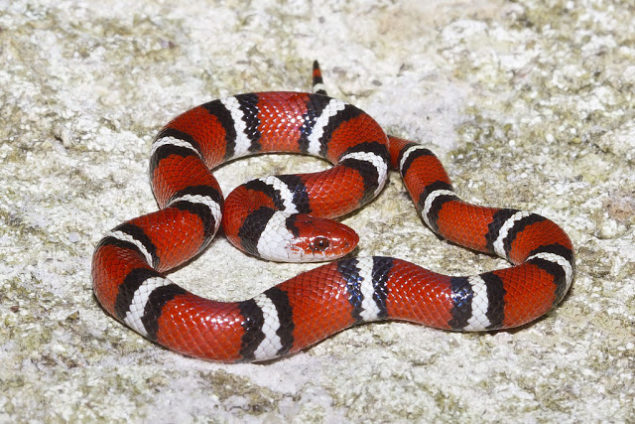Learn all about scarlet king snake size, care, bite and adaptations. Lampropeltis is derived from the Greek words lampros which means “radiant” and pelta meaning “small shields”.
The scarlet king snake, Lampropeltis elapsoides, copies the stripe patterns of deadly coral snakes, Micrurus fulvius, so well that people use mnemonic rhymes to tell them apart, such as: “If red touches yellow, you’re a dead fellow; if red touches black, you’re all right, Jack.” The species live side by side across much of southeastern North America. The scarlet king snake uses mimicry to dupe predators, such as red-tailed hawks, keen to avoid attacking the venomous reptile.
Nose is red and blunt. The tail is black, red, and yellow (three colors). Scarlet king snakes are oviparous. The female usually lay between 4-12 eggs in rotting wood and beneath rocks and logs; some eggs may be buried several inches deep in the soil. The eggs are usually laid in the early summer. They are creamy-white and slender and most of the eggs adhere to one another. The eggs usually hatch in 2-2.5 months.
This species is secretive, and is adept at working its way beneath bark, logs, rocks, and other hiding places. They are seldom seen in the open except at night or after heavy rains. Diet is primarily lizards and their eggs, but will also consume small snakes and rodents.
The longevity record of this species is 22 years and 4 months. Potential predators include skunks, opossums, and raccoons. Scarlet king snakes are chasing an evolutionary ghost. In North Carolina’s Sand hills forest, the harmless snakes have evolved to better resemble a poisonous species that vanished from the region more than 50 years ago.
What is Scarlet king snake?
Body is marked with broad bands that completely encircle the body. Red and yellow-white bands are separated by black bands; yellow-white and red bands never touch. Snout is pointed and red, and a wide black band runs across the back of the head. Scales are smooth. It is often mistaken for the venomous Coral snake. This snake lays eggs.
Scarlet king snake Range
Scarlet snakes are found throughout Coastal Plain and Piedmont regions of the southeastern U.S., from the Pine Barrens of New Jersey west to Oklahoma and throughout Florida. Within this region, however, they are generally most common in the Coastal Plain and Sand hills and are uncommon and scattered in distribution within the Piedmont. In our region, they are found in all but the mountainous regions of northern Georgia and northwestern South Carolina. Scarlet snakes are adept burrowers and prefer forested habitats with dry sandy soils. They are frequently found in pine forest and sand hill scrub habitats
Scarlet king snake Size
Scarlet king snake average adult size is 14-20 inches (35.5-50.8 cm), record is 27 inches (68.5 cm). These largely fossorial snakes are the smallest of all species within the genus Lampropeltis, usually ranging from 40 to 50 cm (16 to 20 in) at maturity. The maximum recorded length is 68.4 cm (26.9 in). Hatchlings range in size from 8 to 18 cm (3.1 to 7.1 inches).
Scarlet king snake Bite
Scarlet king snakes aren’t venomous, so the bite might hurt and take some time to heal (like any wound). Like the other harmless tricolored snakes in the U.S., the pattern of the scarlet snake has been proposed to mimic the venomous coral snakes, presumably discouraging predators. In the U.S., the rhyme “red-touch-black, venom-lack; red-touch-yellow kill a fellow” can be used to distinguish these species. Scarlet snakes rarely bite when picked up.
Scarlet king snake Care
Scarlet king snakes typically eat thawed frozen mice. Baby king snakes will typically eat once or twice a week and should only be fed pink (or baby) mice. Adult king snakes may only need to be fed once a week or less and can be fed adult mice. King snakes should typically be kept in an aquarium that is at minimum 20 gallons, and they should always be housed alone. The tank should be heated to a range of 75 to 85 degrees Fahrenheit, and a shelter, rock or branch and water bowl should be included. The primary health issues for king snakes (and most other snakes) are parasites and shedding problems. A clean, sterile cage can help eliminate a mite problem, while adequate moisture in the tank can usually aid in the shedding process. A snake care sheet found online or in a pet store can be helpful in learning more about shedding.
Scarlet king snake Adaptations
Scarlet king snake (Lampropeltis elapsoides) has evolved even more convincing mimicry. They’re now better imitators than they ever were, and that’s because the trick still works, for now. Batesian mimicry, in particular, is when a toxic species is mimicked by a more palatable one to deceive predators, conferring some survival advantage. The most precise mimics are favored by natural selection when their model becomes increasingly rare. The red and black bands of the recently collected Sand hill king snakes more closely resemble coral snakes, compared with king snakes collected in the 1970s, which have larger black bands. In the 50 years following coral snake extirpation, the king snakes underwent rapid evolution of mimicry. By contrast, no such change occurred in the Florida panhandle where the venomous snakes are still abundant; those mimics were still imprecise.



